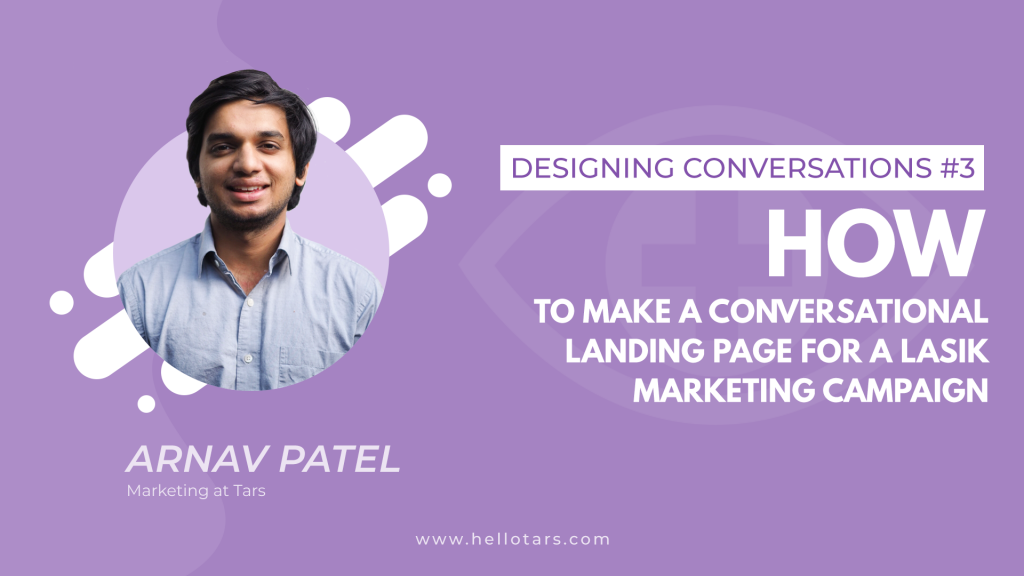For LASIK marketers, conversational landing pages are a useful tool to maximize Google Ads ROI. They increase conversion rate, drop
Greeting Prospects
Prospective patients are like goldfish. Once they click on your ad you have a few seconds to grab their attention or they will get distracted, and drop from your page. Fortunately, conversational landing pages are built for this sort of behavior by nature. Messaging splits information up into small chunks that are more easily digestible than the long blocks of text that adorn landing pages across the web. That being said, here are codified set of best practices for how to write a good hook are a set of best practices you can make when phrasing a hook to ensure maximum conversions:
Send 2-3 Messages at Max
Use an Image and a Welcome Message
Nothing builds legitimacy like branding. If a prospect lands on a page and there is no logo they will question the legitimacy of your page. When they question the legitimacy of your page, they will drop. As an added bonus, images are a great way to catch your prospects attention.
Keep your Messages Short
Again, chat is made for small pieces of information. Don’t write an essay
Capture your Main Value Prop
the second and third messages of your conversation serve a similar purpose as the headline on your website. Think of it as capturing your whole value proposition in a tweet. It should be the sort of offer that makes someone want to continue the conversation.
Make it Easy and Uncontroversial to Respond
giving users a button to respond with allows them to start the conversation much more easily than if you ask them to type out a whole answer (e.g. if you ask for a name).
Capturing the Lead
A conversational landing page isn’t like a form. Prospects can’t see all the fields at once. Rather, they are asked for a single piece of information at a time. This makes for two considerations that don’t exist with a traditional landing page:
Don’t Ask for Personal Information at the Start
This is actually something one of our clients discovered after testing. Digital prospects are apprehensive to share their personal information before they perceive they are receiving any value. In practice, this means that you should first ask prospects a couple of qualification questions that make them feel like the pre-op assessment has already begun (e.g. do you
Acknowledge User Input at Every Stage
Asking for lead information through a conversation has the same end result as a form but it is perceived in a completely different light by prospects.
Prospects expect bot conversations to function in the same way that they do when speaking to another human being.
This is why we encourage marketers to not only phrase each lead generation ask as a full question but also acknowledge each detail a prospect does send.
Answer an FAQ
Most prospective LASIK customers have a certain degree of uncertainty when they click on an ad. They are reasonably certain that they want LASIK but they have a few nagging questions preventing them from scheduling the consultation.
In most cases, this uncertainty stems from a set of basic FAQs that could easily be answered in conversation.
This is why we add an “I have a question” branch to all of our lead gen bots. It gives uncertain prospects a way to feel more reassured about LASIK and reduces the likelihood that they will drop without scheduling a consultation:
Make Your Page Look the Part
Nothing builds legitimacy like branding. If a prospect lands on a page and there is no logo, no consistent color scheme, and a general feeling of the page being generic, they perceive it as spam and are more likely to close out. For this reason, we recommend that marketers use the primary brand colors when theming the message bubbles in their conversational landing page and we recommend sending the company logo in the very first message of the conversation to establish legitimacy.

Arnav is the Director of Content Marketing at Tars. He spends most days building bots, writing about conversational design and scrolling through Giphy’s trending section looking for the gifs that go into the Tars Newsletter.

0 Comments on "[Designing Conversations] How to make a Conversational Landing Page for a LASIK Marketing Campaign"